This is the Canon MC (short for Micro Compact), a compact fully automatic point and shoot 35mm camera released by Canon in April 1984. The MC was conceived as an ultra portable camera to compete with models like the Olympus XA series, except it added the convenience of a motorized film wind and rewind in a body that was extremely small. The MC does not have a built in flash, instead relying on an auxiliary flash unit that attaches to the side.
Film Type: 135 (35mm)
Lens: 35mm f/2.8 Canon Lens coated 4-elements
Focus: Near-Infrared triangulated electronic rangefinder 0.9m to Infinity
Viewfinder: Reversed Galilean viewfinder with projected frames, and zone focusing marks for near, medium, and far.
Shutter: Electromagnetic Leaf
Speeds: 1/8 – 1/500 seconds continuously variable
Exposure Meter: Silicon Photo Diode meter with Full Program AE
Battery: 2 x AAA 1.5v Alkaline
Flash Mount: External Canon Speedlite MC-S (powered separately by 2 x AAA 1.5v batteries)
Weight (w/ batteries): 255 grams
Manual: http://www.cameramanuals.org/canon_pdf/canon_mc.pdf
History

The Canon MC is a “Mini Compact” full frame 35mm point and shoot camera with an uncommon feature set (I’ve learned to stop saying unique because whenever I do, someone ends up pointing out some obscure model I hadn’t heard of with the same feature set). It has a compact clam shell design without a built in flash, much like the Olympus XA-series. Unlike those cameras however, the Canon MC is a full auto focus camera, much like models that came after it.
The body of the camera smaller than most other cameras of the era, and with a large f/2.8 4-element lens, I figured that this should be a pretty special little camera. Although there aren’t a lot of reviews for it online, the ones that I did find were generally pretty positive. The camera has a competitive list of features including programmed auto exposure, fully automatic loading and rewind, a meter with a wide exposure range (for the day), and when loaded with batteries (but no flash), weighs a svelte 255 grams.
This chart from the November 1984 issue of Popular Photography lists the Canon MC among a variety of other compact 35mm cameras of the day. It’s worth nothing that of the models listed, the Contax T was likely an ambitious comparison.
This commercial below suggests a variety of definitions for what “MC” stands for, but it is commonly believed that it was meant to mean “Mini Compact”. Whether intentional or not, the elegantly dressed lady floating in a boat down a canal with Italian music playing likely was done to suggest this was a premium camera so its probably not a surprise to see that the camera had a premium price of $295 with the flash. When adjusted for inflation, that compares to a little over $700 today making it quite the investment for a simple point and shoot.
The early to mid 1980s saw a big change in what was considered an entry level camera. Gone were the days of large and heavy rangefinders and SLR of the 60s and 70s, but the onslaught of throwaway “plastic fantastic” point and shoots of the 90s and 00s were not yet upon us. This era of compact cameras saw several models like the Canon MC that had a nice blend of excellent lenses, innovative features, and a compact size that was still considered to be somewhat capable.
Today, models like the Canon MC aren’t often at the top, or even the middle, of the wish lists of collectors. What constitutes a desirable point and shoot like the Yashica T-series with their Zeiss lenses and a model like the Canon MC is mostly left up to chance. For those willing to take a chance on models like these, there is a good chance you could end up with something special.
Repairs
In the limited research I did before acquiring this Canon MC, I felt as though I had a pretty good idea of what to expect. Many early 1980s point and shoots had similar 4 and 5 element f/2.8 semi-wide angle lenses capable of good or better sharpness and image quality. Most of these cameras offered little to no manual control over exposure, however usually came with a pretty good AE system. Auto focus systems back then were still in their infancy and could only focus on a single spot in the middle of the frame.
The only variable this camera offered over other models like the Pentax PC35AF or the Ricoh FF-90 Super was that this model lacked a built in flash and came in a much more compact body. Canon is no stranger to excellent lenses, and I had really great luck with their earlier Canon AF35M so I figured I was in for a treat.
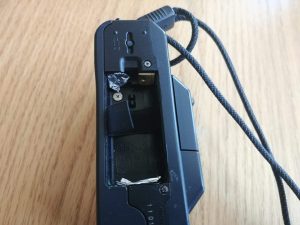
Sadly, the camera showed up in much worse condition than I had hoped. I am used to picking up cameras in “as-is” condition for dirt cheap prices, or in lots of other cameras with very poor pictures, but generally speaking, with a little bit of cleaning and some patience, many old cameras can still be used and I had hoped the same would apply to this MC.
The seller’s pictures conveniently didn’t show the bottom plate of the camera and for good reason. For one, the battery door was completely missing, and what was left there was corroded. Upon further inspection, one of the metal tabs that makes contact with the battery to provide power to the camera was missing. I chalked this up as a total loss and tossed it on a shelf to be dealt with later.
Then, in a fit of boredom this past winter, I picked up the Canon and thought maybe I could clean off the corrosion and shove some aluminum foil in the battery compartment to make a temporary contact point. With the battery compartment cleaned up, I could see where that there was a tiny amount of metal left where the contact point had broken off in the past. I was able to unscrew two screws on the bottom plate of the camera to loosen the battery chamber just enough to shove in a thin folded piece of foil into that slit and make my own battery contact. It wasn’t pretty, but once I shoved some foil in there and wedged in two fresh AAA batteries, the camera sprung to life. Of course not having a door on the bottom of the camera meant that the batteries were constantly at risk of falling out, but at least the camera had power.
My Thoughts
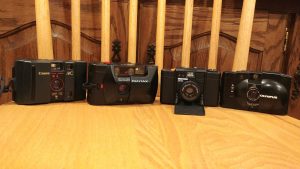
I’m sure you get the point that the Canon MC is small and compact, but perhaps I should backpeddle a bit as it’s not the most compact 35mm camera you could buy. The MC has a slight edge in both height and width to the Minox 35ML and Olympus XA2, both full frame flashless manual focus cameras. Compared to other full frame auto focus cameras, the MC is just as tall as the Pentax PC35AF, but a tad narrower. It is clear that the inclusion of the necessary gearing and electronics for the auto focus part of the camera somewhat offsets the benefit of not having a flash. So while not the most minuscule camera out there, it still fits comfortably into a front jeans pocket and in a front shirt pocket.
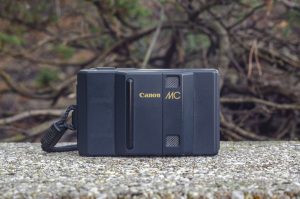
With the camera in it’s closed position, theres not much to see from the front. Both the viewfinder and twin rangefinder windows used for the auto focus system are automatically covered when the slider is closed. There is no door release on this camera like on the Pentax PC35AF, you open it by simply gripping the door and sliding it open. The benefit to this is you don’t have to fumble around locating a small door release and can easily slide it open while holding the camera in nearly any orientation, but the downside is that the door does take a bit of effort to open. There is no spring loaded action like the previous mentioned Pentax has.
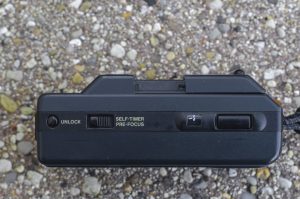
The top of the camera features from left to right, the flash release, prefocus/self timer switch, exposure counter, and shutter release. I found the position of the shutter release to be a little too close to the camera’s right edge for me. A child, or someone with smaller hands might not have had an issue, but I found that an ideal location for my right index finger required me to bend my knuckle a little more than I would have liked. Although I get that this camera is small, there is clearly room to have moved the shutter release a little more to the left.
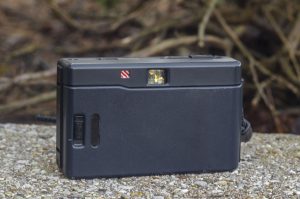
Like the top of the camera, theres not much to the back. The door release is on the door itself with only a sea of dark gray plastic covering the rest. Unlike some other compact cameras like the Olympus XA series with a painted metal rear door, the body covering of the Canon MC does not peel off, and hides scratches and wear marks well, allowing for even the most heavily used examples to look nice. Above the door is a red and white film transfer indicator and the viewfinder. I appreciated the film transfer indicator as the lack of a manual rewind knob means there would have been no other indication that film was transporting correctly into the take up spool.
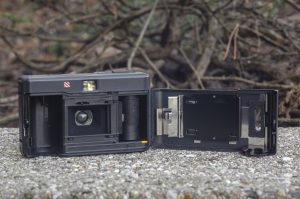
With the rear of the camera open, the Canon is very easy to load. Canon has always been ahead of most other companies in terms of developing quick load film systems and the Canon MC is no different. There is a notch on the bottom left side of the camera that allows a new cassette to slide in without having to worry about pulling up on a rewind knob. The Canon MC does not support DX-encoding, and requires the film speed to be manually set via a dial on the front of the camera. The Canon MC supports a wide range of film speeds from 64 to 1000.
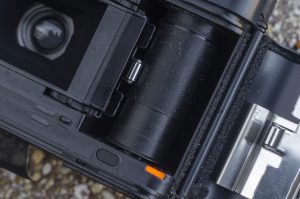
Another nice feature is that the takeup spool has a grippy rubberized coating that makes loading film a breeze. Simply extend the film leader out to the orange mark below the spool and close the door and the camera will do the rest.
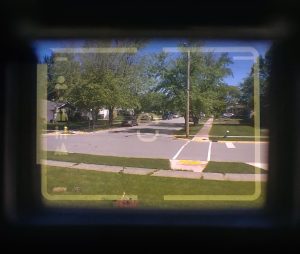
The viewfinder is large and bright compared to other automatic point and shoot cameras of the day. Like much of it’s competition, there are non parallax corrected frame lines indicating the semi-wide angle view, plus an icon-based focus scale on the left, and a oval shaped central focus indicator. If the exposure system detects that a flash is recommended, a viewfinder light in the upper left corner will blink.
Auto focus cameras of the mid 1980s were not capable of multiple focus point detection, so you are limited to automatic focus only in the center of the frame. It is possible to focus on something that’s off center, but it requires a convoluted sequence of steps to get it to work.
First, you must slide the “Pre Focus / Self Timer” switch on top of the camera, then center your focal point in the central oval and completely press the shutter release. This begins a 10 second self-timer countdown in which you can recompose your image however you like. Once you have the image set, a second press of the shutter release will override the self-timer and expose the image. Strangely, once you’ve begun this sequence, there is no way to cancel the self-timer countdown. The camera is going to fire the shutter in 10 seconds or whenever you press the shutter release a second time.
 While this aspect of the Canon MC seems odd today, it’s not exactly out of line for how these cameras worked back then. I can forgive primitive technology, as long as it’s still intuitive, but one thing that really bugged me is that the “dummy” focus scale on the left does not allow you to preview the camera’s detected focus distance. The needle that points to the chosen distance only moves AFTER exposing your image. The camera’s user manual has this warning confirming that this was how it was designed.
While this aspect of the Canon MC seems odd today, it’s not exactly out of line for how these cameras worked back then. I can forgive primitive technology, as long as it’s still intuitive, but one thing that really bugged me is that the “dummy” focus scale on the left does not allow you to preview the camera’s detected focus distance. The needle that points to the chosen distance only moves AFTER exposing your image. The camera’s user manual has this warning confirming that this was how it was designed.
It can be hard for someone used to all manual cameras in which you have control over every aspect of photography to give up control of things like exposure and focus, but when the camera isn’t even telling you what it’s doing until after the shot has already been taken is a bit of a disappointment for me and one aspect of the camera that I strongly disliked.
My Results
With the battery compartment issues that the Canon MC had, I knew it’s current working state was a ticking time bomb so I wanted to get through a few shots as quickly as possible while I had it working to see what it was capable of. I decided to split a 36 exposure roll of Fuji 200 film with the Pentax PC35AF and shoot it over the course of a week in mid February 2018. I had no particular goal for the images I would shoot, so it became a daily point and shoot for me.
My experience with the Canon MC can be summed up with one word, frustrating. Not just because of the battery compartment woes and that I was constantly trying to keep consistent pressure on the batteries to keep them in contact with my jury rigged foil contacts, but the auto focus system was infuriating to me.
If this were a low end camera with a corroded battery compartment, I likely wouldn’t have put as much effort into trying to keep it working, but the Canon MC was built to be an upscale compact camera and I felt like it should have the potential to offer a pretty good shooting experience. It’s original list price of $295 meant that someone had to pay a good chunk of money to get one back when it was first released.
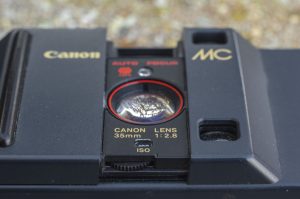
I don’t often use flashes on many of my old cameras, so to have a compact point and shoot of this vintage without the added bulk that a built in flash includes, was actually a pleasure. I found the camera easy to hold and fun to shoot. The viewfinder was large and bright and allowed me to compose my images with ease. I didn’t particularly like the fact that there was no way to detect focus distance before firing the shutter, but as long as the camera did it’s job, that shouldn’t be an issue, right?
Sadly, the problems extended beyond the user interface as several of the images in the gallery missed focus. I cannot tell whether I did something wrong while using the camera, or if the camera’s ailments extended beyond the battery compartment as many of the images came out with soft focus and a disappointing look to them. Fuji 200 isn’t a high end film, but it is predictable and I have a lot of experience with it so I really feel like I should have gotten better results from it. This amplifies my original concern about the camera’s inability to preview focus distance before exposing the image.
Edit 8/6/19: Earlier in 2019, I came across a second Canon MC in much better condition than the first, and it even came with the flash. I figured this would be a good chance to take a second look at this model and see how it would perform. I created a new post with a second gallery of images I got from that camera. See my post and results here:
Which brings me back to frustrating. If this was a crappy junk camera that wasn’t working correctly, I wouldn’t have had a problem scrapping the half roll of film and deleting this review, but I feel as though the Canon MC is more than that. It’s like an auto focus version of the excellent Olympus XA2. I really wanted to like this camera and give you a glowing review, but perhaps it wasn’t meant to be, at least not with this particular example.
In an effort to give you some type of idea of what kinds of images the Canon MC is capable in good working order, I was graciously granted permission by fellow collector Mike Novak who said I could link to his Flickr gallery of photographs he had shot with his Canon MC. Looking through Mike’s images, it is clear that no only is Mike a better photographer than I, but his Canon MC is indeed in excellent working order.
I can’t hold the camera’s physical woes against it, as the perils of time can be brutal to any camera, but for what is supposed to have been a “premium” compact point and shoot, I think Canon could have done a better job with the auto focus system and at least given some indicator of focus before firing the shutter. As for the lackluster images I got, I can’t see how a sketchy battery compartment repair could have caused so many missed focus and exposure shots. Despite these challenges, there is still enough to like about the camera that if I were to ever come across another one of these in better condition, I would definitely pick it up and give it a second go. If that ever happens, I’ll be sure to update this review.
My Final WordHow these ratings work |
The Canon MC is part of a very short lived category of “premium” compact point and shoot auto focus cameras. With a list price comparable to $700 today, it had a good 4-element f/2.8 lens, good auto exposure and auto focus systems, a feature set consisting of auto rewind and auto advance, and it came in a very portable package with a sliding front door. One thing the Canon MC couldn’t do is overcome years of abuse and age, and the example I used was in poor shape and returned images that I don’t think are indicative of what it was capable of. Although I see great potential in this camera, my opinion is tainted somewhat by it’s condition. I think that in better shape, this could have been a fantastic camera, so don’t let my bad experience dissuade you from picking one up if the opportunity arises. | ||||||
| Images | Handling | Features | Viewfinder | Feel & Beauty | History | Age | |
| 0 | 1 | 1 | 1 | 2 | 0 | 0% | |
| Bonus | none | ||||||
| Final Score | 5.0 | ||||||
Additional Resources
http://camera-wiki.org/wiki/Canon_MC
http://global.canon/en/c-museum/product/film113.html
https://www.photo.net/discuss/threads/canon-mc.126923/
https://theshuttergoesclick.blogspot.com/2010/10/with-canon-mc.html
http://e-ca.pagesperso-orange.fr/Canon-MC.htm (in French)

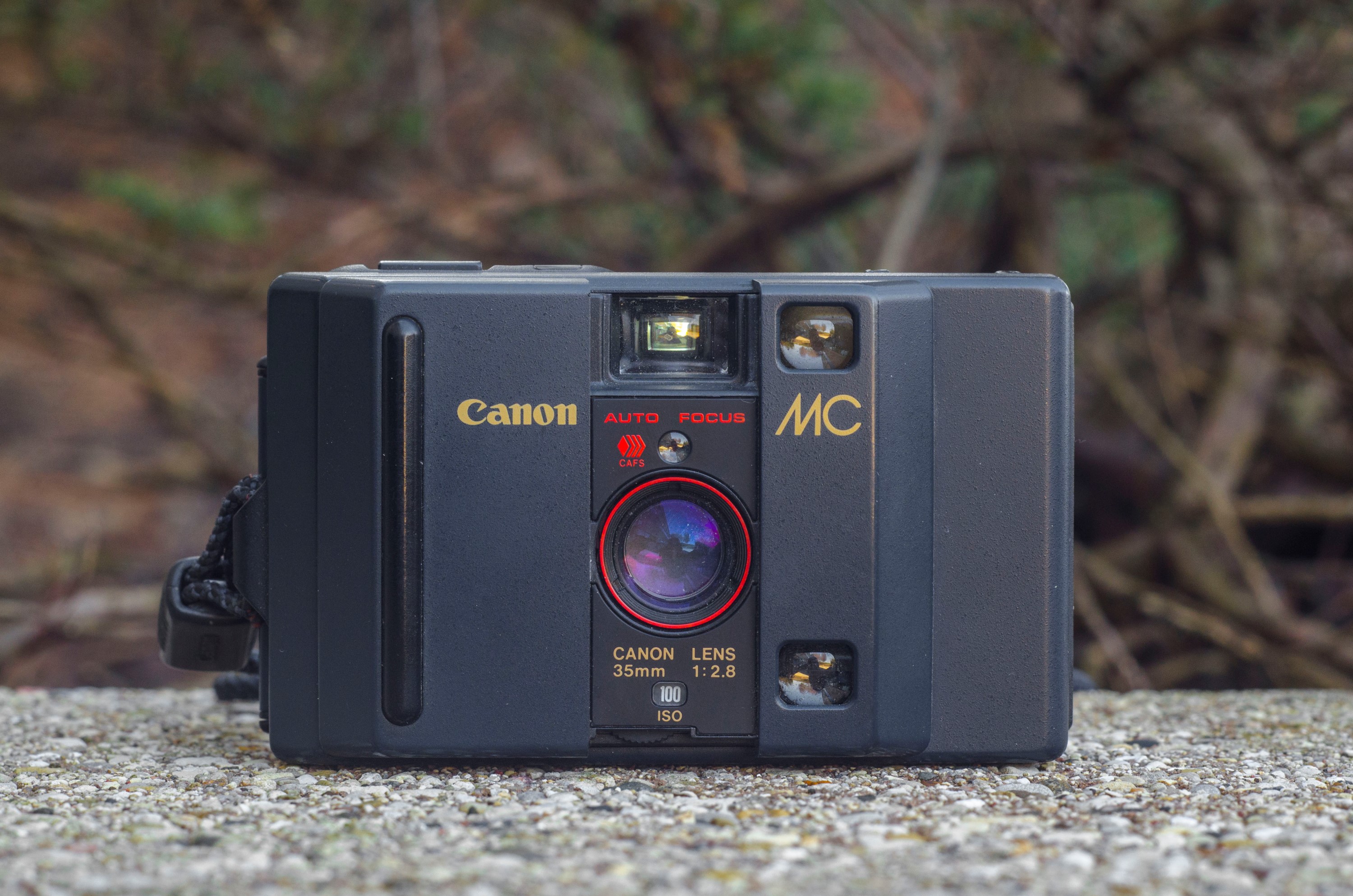
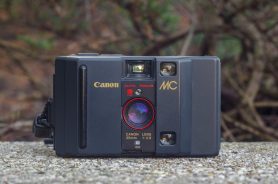
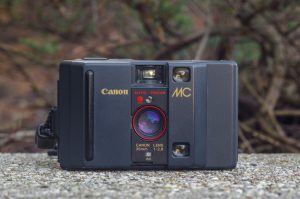









Very informative revue.I just put a film through my 35MC, and did a short blog post about it. I quite liked the camera and was surprised by how good the results were, I bought the camera from a dealer, it looked like it had never had a film through it.
Art, can you share a link to your blog? I will add it to the Links section in the review!
Thanks Mike it’s – https://coronet66.wordpress.com/2018/05/30/canon-35mc/
Just a point about pre-focus function. Second press of shutter release WILL trigger shutter immediately without waiting for the self timer to do it. Only if if you do NOT press the shutter second time will the self timer come in t do it for you. Second shutter press releases the pre-focus switch back to normal position, so if that did not happen on yours it did not work correctly.
Luke, you’re correct, but in my review, I state “First, you must slide the “Pre Focus / Self Timer” switch on top of the camera, then center your focal point in the central oval and completely press the shutter release. This begins a 10 second self-timer countdown in which you can recompose your image however you like. Once you have the image set, a second press of the shutter release will override the self-timer and expose the image.”
A second press of the shutter release triggers the shutter immediately like you said, but I never disputed that! 🙂